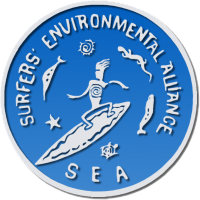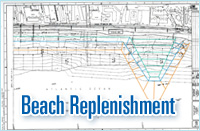US ARMY CORPS of Engineers adopts Surfers’ Environmental Alliance (SEA) design for modified beach replenishment project. For the better part of the last decade SEA activists, including the current acting executive director Andrew Mencinsky, have been working with local, state, and federal officials to modify the unnatural straight line design of beach fill projects. “Our position has been consistent from the beginning that the straight line and steep beaches created in New Jersey in what is the nations largest beach building project would destroy surfing and create unsafe swimming conditions. After proving the American Shore & Beach Preservation Association(ASBPA ), the New Jersey Department of Environmental Protection(NJDEP) and the Army Corps of Engineers wrong on their stance, SEA set out to lobby for the sand feeder project. This plan would have less impact, create a potential surf spot and possibly have a longer lasting outcome than typical straight line projects. According to Mencinsky, this design is “intuitive engineering”. By visually studying beaches around the world and understanding local winds, waves and currents, we believe creating feeder sand points may be the solution in many areas where sand replenishment is the desired course for shore protection.
“Essentially”, said the DEP’s David Rosenblatt, “the design will create a protrusion of sand away from the shoreline”. This protrusion will serve as a “feeder beach”. As the sand erodes from the feeder beach, it will settle on the main beach.
This will, theoretically, extend the life span of the project and allow waves to break farther out to sea, improving surfing conditions and sparing the actual coast from a more direct battering. In short, this combination enhances shore protection.
Congressman Frank Pallone said it was NJDEP Commissioner Lisa P. Jackson who supported investing in the new design, which, if successful, could be used in other areas of the coastline.
Surfers have maintained for years that the old, straight-line beach renourishment destroyed surfing in other locations, particularly Sea Bright where 12 years after sand was first pumped on beaches there, the sport has virtually disappeared.
According to the DEP’s Rosenblatt, who is the administrator of the Office of Engineering and Construction, the new design could extend the life of the project without creating “undesirable effects of beach fills like in other areas of Monmouth County . . . like Sea Bright where the waves that used to be good for surfing more or less disappeared.”
Stevens Institute of Technology in Hoboken will analyze the movement of the sand and wave characteristics to see if the new design is successful in preserving recreational opportunities as well as enhancing shore protection, he said.
“We’ve been working with the surfing community over a number of years trying to devise a plan that might satisfy their interests and ours,” Rosenblatt explained. “This seems to be a logical project design.”
Pallone said he has had countless meetings over the last three years not only with surfers but with swimmers and body surfers who maintain that beach replenishment makes the beach more dangerous for swimmers and ruins the waves for surfers.
The new design will be implemented November 2008 in the west end section of Long Branch New Jersey. SEA will be monitoring and documenting the results of the project via aerial photos. We are working with LightHawk, a non-profit aviation organization dedicated to championing environmental issues through flight. Working with experienced volunteer pilots, LightHawk donates program flights to conservation and environmental groups working in ten countries. Many thanks to LightHawk for all of their support.
The Corp Reform Network is funding part of this project.

